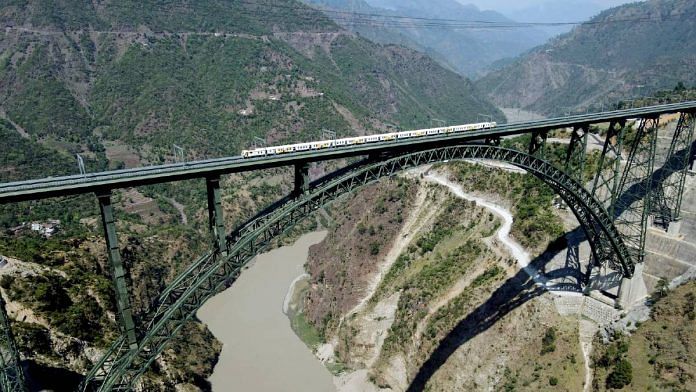All eyes are truly on Reasi now, which, exactly a year ago on 9 June, was the scene of a dastardly terror attack on Hindu pilgrims by the TRF—the very perpetrators of the Pahalgam attack. PM Modi has given a befitting reply to Pakistan-sponsored terrorism by inaugurating the highest rail bridge in the world.
The Kashmir Valley has remained mostly cut off from the rest of the country due to the obsolete Article 370, as well as physical barriers. The Chenab Bridge has forged a connection, the missing link on the Jammu–Baramullah train route, which in turn connects the Valley with the rest of India.
After 1947, the Valley saw periods of alternating peace and turmoil until 1989, when it spiralled into a vortex of Pakistan–sponsored terrorism, after targeted killings of Hindus by militant groups such as the Jammu Kashmir Liberation Front. This led to a mass exodus of Kashmiri Pandits from the region.
Prior to this period, the Kashmir Valley saw a period of peace, when it was the favoured location for Yash Chopra—my favourite director—who filmed iconic scenes from classics like Daag and Silsila. Who can forget Shammi Kapoor’s song, Yahoo Chahe Mujhe Koi Junglee Kahen?
Today, the breathtaking Baisaran Valley has gained infamy due to the tragic terror attack, but it once formed the backdrop against which Shammi Kapoor and Sharmila Tagore romanced in the 1964 hit Kashmir ki Kali. It was also the setting for Arzoo and Jab Jab Phool Khile.
In the 1970s, iconic hits such as Kabhi Kabhie and Roti had scenes that were shot in the valley. And who can forget the musical Neela Aasman So Gaya?
After 1990, a period of insurgency restricted access to the Valley, and only a handful of films were shot well up to the early 2000s, including Roja and Mission Kashmir. These blockbusters had the Kashmir unrest and insurgency as the primary theme. Even in relatively recent films such as Haider and The Kashmir Files, the focus has been on the post-1990 suffering of the Kashmir Valley.
The hope is that the Chenab Bridge and the Udhampur-Srinagar-Baramulla rail link will bring Bollywood and other film industries back to the Valley. The film–tourism synergy is substantial, and Kashmir’s annual tourism industry is worth .
The Chenab Bridge is a prime example of India’s unity. There was no North-South, Hindu-Muslim divide at play during the execution of the iconic structure. The entire country worked as one for its construction and execution.
Rock engineering specialist G Madhavi Latha, a professor at IISc, Bengaluru, spent 17 years working on the stability of the foundation. Her team used a “design as you go” approach—the terrain was so complex and challenging that the team had to keep modifying calculations and the design was continuously evolving. IIT Delhi professor KJ Rao was a project consultant, and IISc professor TG Sitharam was the geotechnical consultant during 2005-2020.
“The Chenab Bridge is more than a technical achievement — it is a story of human endeavour, of teamwork, of innovation under pressure, and above all, of patriotic purpose,” Sitharam wrote. His words echo the pride of all Indians.
Researchers and engineers like Sitharam across the country take pride in this monument to India’s technical talent.
The steel used in the columns was manufactured by engineers from Steel Authority of India Limited in their plant in Bhilai, including of TMT Steel, 6,454 tonnes of plates and 56 tonnes of structural steel. The remaining steel was brought in from SAIL’s Bokaro, Rourkala, and Durgapur plants.
Afcons Infrastructure Limited, headquartered in Mumbai, was the contractor for the construction. The project provided employment to over 1,000 Reasi locals. And while the area comes under Northern Railways, the branch was only pleased to partner with Konkan Railways, given the latter’s expertise in railroad construction in difficult terrain. Defence Research and Development Organisation (DRDO) provided inputs to make the bridge blast-proof.
We can safely state that the Chenab Bridge is a mile sur mera tumhara moment in Indian history.
I have been told by friends and acquaintances in the Valley that the Governor’s rule ensured a period of peace and stability in Kashmir. However, conducting free and fair elections is one of the main pillars of democracy. And the BJP government fulfilled its commitment to democracy by ensuring that elections were peacefully held for 90 Legislative Assembly seats in 2024. The INDIA bloc won 49 seats, leading to Kashmir’s first elected government after the abrogation of Article 370, which paved the way for self–governance for the Kashmiri people.
Critics of the BJP’s handling of Kashmir may read , which appeared in ThePrint on 14 October 2024. Omar Abdullah was elected CM in a peaceful election process that saw a whopping 63.8 per cent turnout.
“Many people dreamt of this train service. What the British could not do, you [PM Modi] got it completed, and Kashmir Valley has now been connected with the rest of the country,” CM Abdullah said during the inauguration ceremony.
The bridge will now serve as a gateway for the process of self-governance for the Kashmiri people, with Panchayat elections on the anvil as the electoral rolls have been updated in January.
On the day of the Pahalgam terror attack, there was an unprecedented footfall of tourists in Kashmir. Tourism had surged in recent years, peaking at in 2024, and in 2025, was expected to breach that number by the end of the summer holidays. The Chenab Bridge is predicted to boost tourism in the region, as the rail link from Srinagar to Jammu will connect onward to New Delhi and provide a more economical travel option for tourists.
Apple growers are also likely to benefit. Over 75 per cent of the country’s apple production comes from the Valley, which also accounts for 8 per cent of Kashmir’s GDP.
“Poor connectivity has negatively impacted the economic development of 70 percent of the Valley’s population, which is dependent on farming and perishable fruit cultivation,” the article by Ayjaz Wani in ORF’s ‘Expert Speak’.
Beyond apples and plums, all–weather rail connectivity and access to rail cargo services will provide access to newer markets for Kashmiri almonds, walnuts, saffron, cherries, and other fruit. The Chenab Bridge will serve as much more than a connection between two banks of the Chenab River. It will become the lifeline to the Kashmiri economy, linking the once–isolated Valley to the rest of the country. The bridge and the rail link provides a physical manifestation of what every Indian lived by—Kashmir is an integral part of India, and it won’t be left behind on the highway to Viksit Bharat 2047. Our Kashmiri brethren will walk into a new dawn of development and prosperity, unlike their neighbours in the Pakistan-occupied part of Kashmir.
India supplies the world with STEM talent. Why should this technical talent not be used for the advancement of our national interest? The Chenab Bridge is 35 times the height of the Eiffel Tower and 1,315 m long, with an imposing steel arch span of 467 m. Designed to withstand zone V earthquakes and wind speeds of 256 km/hr, it straddles a seismologically rugged Himalayan terrain in the comparatively young mountains of the Pir Panjal Range and is connected with two steel pylons.
The bridge has a lifespan of 120 years and can support a train speed of up to 100 km/hr. This technological marvel is capable of withstanding high-intensity explosions equivalent to 40 tonnes of TNT and extreme temperatures down to -20 degrees Celsius.
Symbolically, the Chenab Bridge is also a bridge to gender equality in India. The presence of women in leadership roles, such as G Madhavi Latha, challenged stereotypes and inspired a generation of young women to pursue careers in STEM. Latha has been a trailblazer her entire life.
“At a particular slope cutting, I remember spending sleepless nights as my inputs were required at every stage,” she while sharing the challenges her team faced in executing the project.
The Jammu–Srinagar travel time has been reduced to around three hours, and the Vande Bharat trains are a safe and convenient way to travel. Thus, the bridge is critical for the autonomy and mobility of women in the region. Even critics like Iltija Mufti have admitted that the bridge is a “welcome step”.
The photo of PM Modi holding the Tricolour and marching confidently on the bridge showcases India’s resolve and resilience: Nothing can deter us from achieving our goals of prosperity and peaceful coexistence. Like the steel used in the construction of the Chenab Bridge, Indians have forged a new future that is different from the traps set for us. Our stellar resolve will take us forward. This grateful citizen thanks all the researchers, engineers, workers, and agencies involved in the execution of this project, but most of all, our honourable prime minister, who helped bring it to fruition despite the many challenges.
(Edited by Prasanna Bachchhav)








